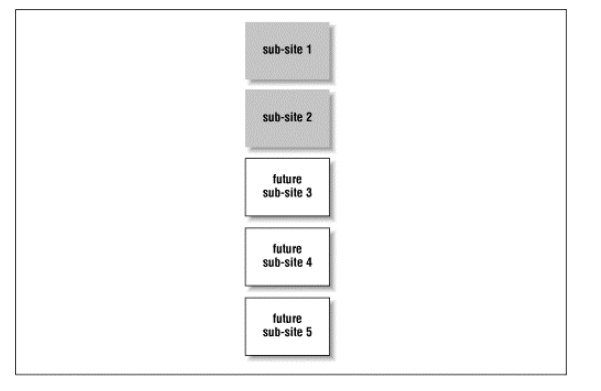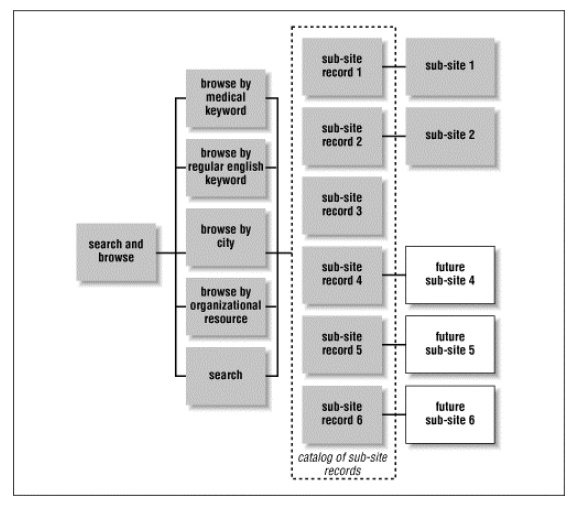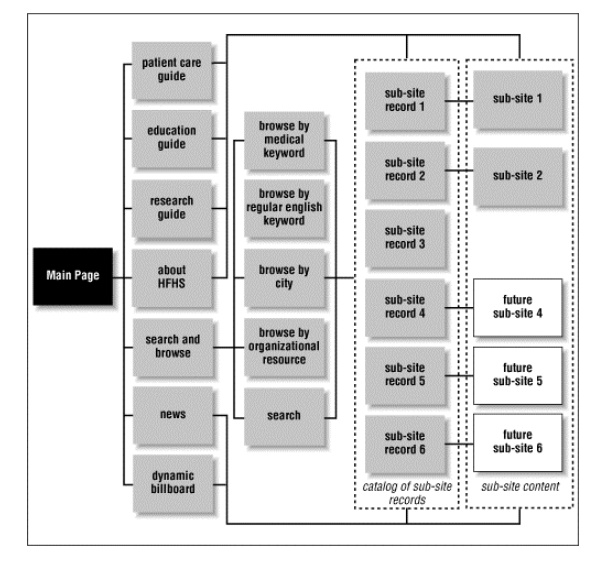Chapter: Information Architecture on the World Wide Web : Information Architecture in Action
A Case Study: Henry Ford Health System
A Case Study: Henry Ford Health System
The Henry Ford Health System (HFHS) is one of
the largest health care providers in Michigan, with over 17,000 employees and
almost $2 billion in annual revenues. They approached Argus and its strategic
partners, Q LTD (which provides graphic design and editorial services) and
InterConnect of Ann Arbor (which provides programming and technical design
consulting) to create an external corporate web site from scratch. Needless to say,
we were delighted to take on the project. We also realized that we would need
to avoid the usual problems of main page crowding, political jockeying, poor
navigation, and inconsistent look and feel that were abundant in many other
health care organizations' sites. Although the HFHS internal Internet committee
was very sensitive to these problems, we all faced a huge challenge of creating
a useful, user-centered site for such a large corporation.
1. Org Chart as Default Architecture
We began with the assumption that we could not
force the 90 or so HFHS hospitals, medical centers, departments, units, and
programs to halt their own web development efforts and comply with the look and
feel of the site we were about to create. In fact, it would be better to accept
the reality that sites grow organically within an organization, and build a
strong umbrella site around these local islands of corporate information. So,
we began visualizing an architecture that looked like the one in Figure 10.1.
Figure 10.1. The Org Chart architecture. It obviously won't
scale well for most large organizations. Imagine a main page with links to 90
sub-sites... on second thought, we're sure you've seen quite a few of those!

Each sub-site represented an organizational entity : a department,
unit, division, medical center, hospital, or program sponsored by HFHS. We
learned from our initial research that many of these entities did not yet have
their own sub-sites, although they would over time. Some entities might never
create their own sub-sites. So the reality of their web environment really
looked a bit more like Figure 10.2.
Figure 10.2. Expecting future growth

The organization scheme at this point very
closely mirrored the political boundaries of the HFHS org chart. Users might
come to the main page of such a site and find prominent links to the Department
of Gynecology next to the Office of the President. Also, as HFHS is a large
organization, there would be many more links than the five represented here. So
how could we leave these default organic partitions of information in place,
and yet provide a more usable, user-centered view? We had to find a way to cut
across the grain of the org chart, yet leave it in place (see Figure 10.3).
Figure 10.3. Unless we come up with a better solution, the site
will be organized like an "org chart" (the horizontal dotted lines).
Can we cut "across the grain" of the org chart (the vertical dotted
lines) for a more user-centered approach?

2. Sub-Site Record Pages
Our solution was to create a database of
records or meta-information pages to represent each sub-site. These sub-site
record pages include information about
each sub-site, and are centrally created and controlled by HFHS. Together, they
serve as a catalog for the site's sub-sites; using database technology, they
are easy to maintain and content duplication is minimized. The fields in these
records and the relationships between each type of record were determined
through a fairly conventional process of data modeling. The use of fielded
information supports improved information retrieval, as described in Chapter 6. Also, the whole structure of sub-site
records can be bypassed if need be, with users bookmarking an individual
sub-site's main page if they so desire.
The sub-site record approach allows the
sub-sites themselves to be controlled autonomously and anticipates sub-site
growth well. If a sub-site existed, a sub-site record page would also link to
the sub-site. If no sub-site existed yet (e.g., sub-site records 4 through 6 in
Figure 10.4), the sub-site record would serve
as a placeholder until it could be linked to a new sub-site. If a particular
department wasn't likely to ever create a sub-site, the sub-site records would
at least provide useful information about that department (e.g., sub-site
record 3).
Figure 10.4. Sub-site record pages allow other ways of accessing
the site's content, and help delineate responsibility for content ownership and
management.

3. Labeling Systems for Sub-Site Record Pages
To address the need to cut across the grain of
the default org chart-centered organization scheme, the sub-site record pages
include manually created keyword indexing to support various user-centered
means of accessing the sub-sites. In this case, we worked with HFHS' staff
librarians to index each sub-site using medical terms in schemes that matched
their two primary audiences: one controlled vocabulary for medical
professionals and another for regular people. On each sub-site record page,
these terms were shown together in one keywords field. Within that field, the
keywords served as links to other sub-site record pages which had been
similarly indexed, which can greatly enhance user navigation (for example,
users can find other HFHS resources that are related to cancer - see Figure 10.5).
Figure 10.5. A sample sub-site record page can work as a
placeholder or as a link to the actual sub-site. It also helps maintain a look
and feel consistent with the remainder of the umbrella site.

These topical keywords provide access to the
HFHS sub-sites' content in a more user-centered manner than the org chart
approach did. We also provided other ways of navigating the sub-sites, leveraging
the sub-site records to allow browsing by Organizational Resource (e.g.,
hospital vs. program vs. department and so on), and by location (City). And we
did maintain a browsable org-chart index (Browse By Organizational Resources);
browsing the site in this way remains useful in certain cases, especially for
internal audiences.
4. Searching System
We also included a searching facility to allow
for fast known-item searching (and, as you can see in Figure
10.6, we integrated
it with the browsing options). Queries are run against a set of fields that we
selected from the
sub-site record pages, including document titles, descriptions, and keywords.
Such selective indexing supports improved searching results because queries are
run against homogeneous information created and maintained by the same central
authority. The results are far more consistent than if a single index of all
the content in all of the sub-sites could be created. Creating such an index
could also be challenging if the owners of certain sub-sites disallowed spiders
to crawl their sites.
Figure 10.6. Multiple means of searching and browsing the
sub-site record pages' content.

The architecture now looked something like
that in Figure 10.7.
Figure 10.7. Another view of the multiple means of browsing and
searching the sub-site record collection.

This architecture provides quick and easy
access to content in sub-sites, especially for users who already know what
they're looking for or who understand a bit about the nature of HFHS. Users can
get straightforward lists of all that HFHS has to offer by city, by keywords,
by searching, and so on. But what about users who don't really know what
they're looking for? Or those who need a warm, fuzzy introduction to the Henry
Ford Health System in general?
5. Guides
To give users, especially first-timers, a view
of the HFHS web environment that goes beyond raw lists of sub-sites, we worked
with HFHS staff to create guides17 to HFHS and its information.
Guides add value to the user's experience by telling a story about the site; in
effect, they come as close as the Web can to serving as friendly tour guides.
They wrap narrative text around featured links to sub-site record pages (or,
for that matter, actual sub-site content) in a way that educates users about
the site and its sponsor (in this way, they can allow marketing goals to be
met). They can stand alone: guides provide value for users even if they don't
wish to pursue the links. Guides also can be customized for different audiences
or needs, and they can exist somewhat independently of the changes that might
happen in the sub-sites themselves.
For HFHS, we identified major information
needs that users might have when they reached the HFHS main page. Besides
wanting to find a sub-site (which we'd already covered with the architecture
we've shown so far), users might be members of four primary audiences:
•
Medical students who were considering doing their residencies
at HFHS.
•
Researchers, both internal and external, who want to keep abreast of the role
that HFHS plays in medical research.
•
Patients who want to know about the care they could receive at HFHS.
•
Generic users who want to know about HFHS in general.
We knew other audiences could be served by
guides, and that there were other ways to define guides, such as by topic or
task. But, after much discussion, we felt that these four guides would address
the needs of perhaps 80% of first-time users of the site. What about the
additional 20%? We hoped that they would be served by the Help Yourself search
and browse features. Realistically, our feeling is that most sites' main pages
probably don't address even 50% of their users' needs, so we felt that 80% was
a pretty good goal. (In fact, the 80/20 Rule is good for web developers in
general; use it to remind yourself that you can't always satisfy 100% of all
possible users of your site, but that if you can assist 80%, your site will do
better than the majority of its competitors.)
Each of the four guides would describe HFHS's
offerings in a style that best fit the needs of each audience. Also, each guide
would link to the subset of HFHS sub-sites that was relevant to that particular
audience (see Figure 10.8).
Figure 10.8. A sample guide's main page. Audience-specific
narrative text is on the right and links to sub-site records and other useful
resources on the left.

6. Multiple Pathways to Content
Now our architecture supported different ways
to get users to information in the HFHS Web environment. Users doing
exploratory searching could easily move back and forth between browsing and
searching a catalog of sub-site records. Known-item searchers and repeat users
could go right to the search engine or quickly scan the browsable indices. New users
who wanted a better sense of what HFHS offers could get a taste through any of
the four guides to selected HFHS sub-sites. The top-level information
architecture was nearing completion (see Figure 10.9).
Figure 10.9. Value-added guides complement searching and
browsing plain lists of resources.

There were still some other areas we'd not yet
dealt with. One area was the news announcements and press releases that HFHS
would naturally want to make available. We created a news area in the site and
augmented it with a dynamic billboard that showed news headlines and, when
clicked, would take users to the story that it had introduced. The billboard
adds nice visual splash to the main page. It also helps defuse potentially
sticky political situations by unburying sub-site content that deserves
occasional exposure on the main page. At this point, we also added the de
rigeur "About HFHS" section. So the final top-level architecture
looked like Figure 10.10.
Figure 10.10. The full architecture, including two new ways of
reaching content (news and the dynamic billboard).

Pretty confusing, eh? Certainly the blueprint
diagram is overwhelming; that's why we always use mock-up pages at this point
in the conceptual design phase. However, when you look at the final product,
the main page for this site (Figure 10.11), you
will note its simplicity.
Figure 10.11. The HFHS site's main page - a concise gateway to a
complex information environment

The HFHS main page has few links, a balance
between static and dynamic information (e.g., the dynamic billboard at the top
of the page), and no names of departments, units, or other political entities
that might typically sneak their way there due to political infighting. Yet it
provides users with ten ways to reach
information in the HFHS Web environment:
1. Browse by Keyword (both medical and lay)
2. Browse by Organizational Resource
3. Browse by City
4. Search
5. Patient Care Guide
6. Research Guide
7. Education Guide
8. About HFHS Guide
9. News Area
10. Dynamic Billboard
7. Conclusion
We addressed the issues of politics and main
page cluttering by creating additional real estate, in the form of guides, just
off that most prime real estate, the main page. We moved mention of and links
to individual sub-sites from that main page to these guides, thus reducing the
clutter of the main page. This approach could be embodied as a policy that
would stand up to any unit or department demanding to be linked to from the
main page.
We also architected and created a catalog of
the entire HFHS Web environment. This alone was a first for the organization:
there had never been a comprehensive, up-to-date publicly accessible catalog of
HFHS and its offerings. This represented a huge value-add for users. From a
maintenance perspective, the sub-site record pages, as well as the various
browsable indices, could all be generated by a database. New records could be
added without affecting the overall architecture.
We addressed navigation challenges by creating
many different ways for users to browse information, and applying these
navigation systems consistently on the site's pages (thanks in part to
generating these pages from a database with easily configurable templates). We
believe that searching performs better thanks to the use of search zones and
controlled vocabularies.
Lastly, we allowed sub-sites to maintain their
own personalities independently of the umbrella site. We also provided a style
guide for others at HFHS to create sub-sites that match the umbrella site's
look and feel. Better a carrot than a stick!
All of this was accomplished by considering before production the needs of the
site's users and fitting the organization, navigation, labeling, and searching
systems around those needs. What we've covered here is an illustration of what
information architecture is all about.
We don't intend to portray the architecture
depicted in this case study as one-size-fits-all. We feel that it works well as
an external site for a large, distributed institution. There are bits and
pieces of it that you might apply to your situation, but your site might
benefit from a completely different architecture. Your mileage will certainly
vary. But as long as you ask the questions, plan ahead, and consider the user,
your information architecture should succeed.
Related Topics